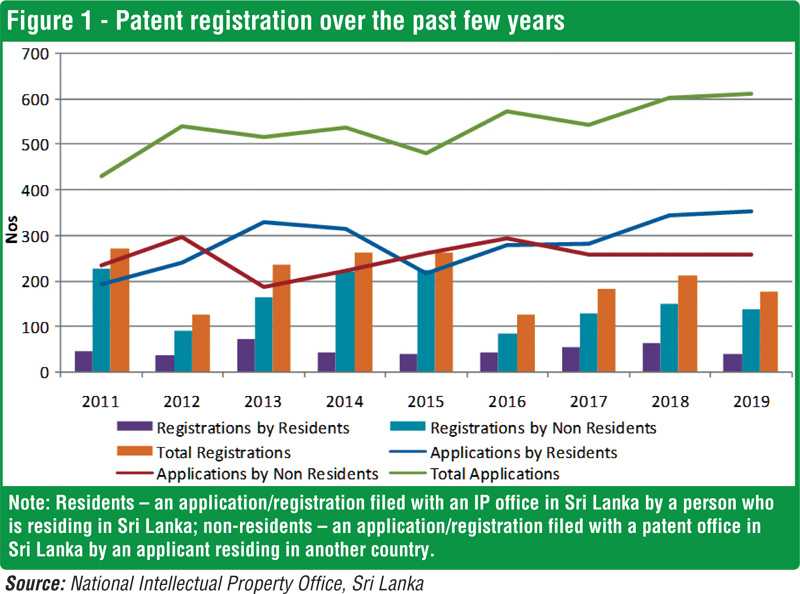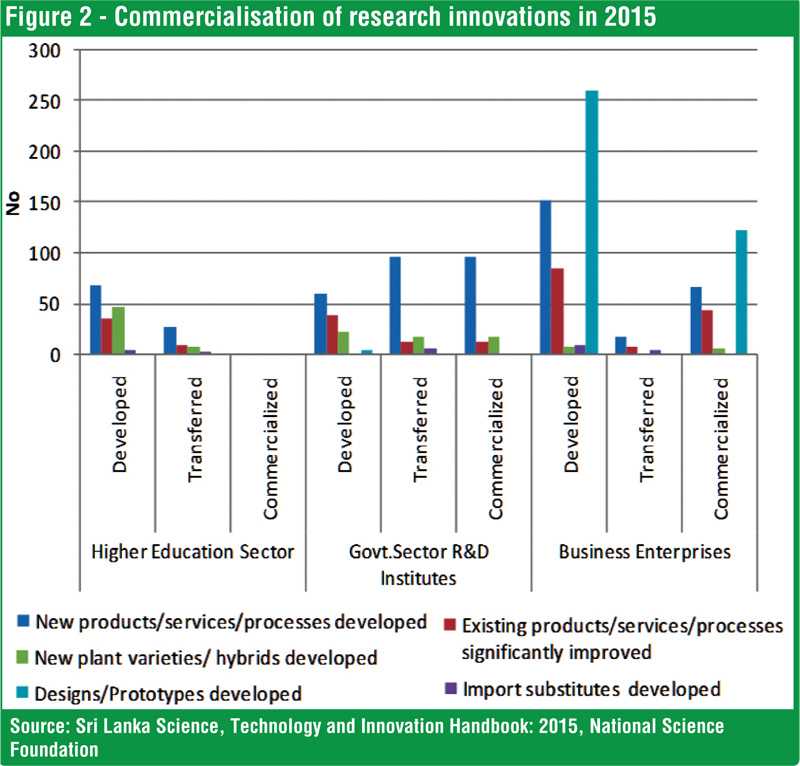Saturday Mar 15, 2025
Saturday Mar 15, 2025
Wednesday, 2 December 2020 00:34 - - {{hitsCtrl.values.hits}}

By Dilani Hirimuthugodage
Way back in 1945, renowned author Kumarathunga Munidasa wrote in ‘Virith Vekiya’: “A nation that does not invent and produce new things will not thrive.”
The visionary Munidasa clearly understood the importance of innovation for economic and social progress. Today, it is telling that Sri Lanka ranks at 101 in the World Intellectual Property Organization (WIPO)’s Global Innovation Index (GII) for 2020 – a considerable drop of 12 places from last year – and earning a pitiful score of 23.78 on a scale of 0-100, 100 being the most innovative.
However, according to the Sri Lanka Inventors Commission, there were 200 innovations since the COVID-19 outbreak in March. This is a noteworthy increase in a short period. These innovations are mostly scientific or technological and focus on various practical and medical necessities that have arisen directly from the pandemic. Yet only a very few of these innovations were commercialised during this period.
At this juncture, it is essential to make inventions and innovations commercially viable products and to use them effectively to contain the virus. This blog highlights the importance of Intellectual Property Rights (IPRs) in the commercialisation process and suggests some strategies to advance the commercialisation process in Sri Lanka.
Background
Three concepts are vital in introducing new products and processes to the market: invention, innovation and commercialisation. IPRs are important in the process of commercialisation as they facilitate the process of bringing innovative technology to the market by safeguarding inventor creativity. Further, IPRs give inventors the right to prevent or allow third parties to commercially use the products. Only the products or processes which are protected by IPRs will benefit from the commercialisation process.
Patenting is the most suitable protection method for innovations under Sri Lanka’s Intellectual Property Rights Act of 2003. Patents are available for inventions, products and processes in all fields of technology. Once obtained, a patent is valid for 20 years. However, the patent holder has to re-validate the patent license annually by paying a fee to the National Intellectual Property Office (NIPO).
Usually, if the innovation has a good commercial value, the patent holder tends to renew the license annually. However, if there is limited commercial value, the inventor may decide to abandon the patent as the renewal of a patent is also costly, and at which point the innovation will be in the public domain for free use. There are other IPRs such as copyrights, trademarks and trade secrets to protect innovations.
The status quo
An important criterion to evaluate a country’s innovations is the number of intellectual property (IP) filings by residents and non-residents over the past few years. Sri Lanka shows a fluctuating trend in the total number of patents registered locally by residents and non-residents since 2011. (Figure 1). However, it shows an increase since 2016 and a slight decrease in 2019. Moreover, it is important to see how many of these innovations become commercially viable.
As shown in Figure 2, business enterprises are leading in developing, transferring and commercialising innovations, whereas the performance of the higher education sector and public R&D institutes are unsatisfactory according to the latest available data. This could be due to low number of researches conducted by such institutes, lack of research interest among staff and students, the poor management system of IPRs, lack of awareness of patenting, and the high cost of patenting.
When compared with 2013, there is an increase in commercialisation of innovations in the government and higher education sector by nearly 68 %, however, business enterprise data are not available. Nevertheless, Sri Lanka is not at a satisfactory level when compared with its peers in South and East Asia. According to GII 2020, knowledge and technology outputs which take innovation and commercialisation into consideration, Sri Lanka was ranked at 68 out of 131 countries, whereas Singapore was at 14th, India at 27th and Malaysia at 38th places, respectively.
The Coronavirus Innovation Map, also ranks Sri Lanka at a very low level. The United States leads the global coronavirus innovation efforts whereas China and India lead the Asian region. One of the main reasons for the low ranking in the Coronavirus Innovation Map is the lack of IT and online facilities available at present for patenting and lack of technical staff at NIPO for innovation examinations and registration during this pandemic period. Moreover, due to a lack of awareness of IPRs, they are not applying for IPR registrations.
What can be done?
There are several strategies that Sri Lanka can adopt to encourage innovations and speed up the process of patenting especially during this pandemic. As a first step, it is necessary to create public awareness on IPR services, especially patenting, its importance, how patents support and encourage inventors by providing recognition and rewards, and how to convert inventors’ knowledge into tradable assets.
NIPO has introduced an online patent application system since April 2020 and is conducting online patent examinations. This information should be made available to the public. Equally, it is vital to recruit technically-sound IP examiners and to also provide IT facilities for virtual examinations, remote working to examine IP applications relating to COVID-19, and to speed up the patent examination process. If these practices are not implemented, the technology would get outdated and not be put into use. Sri Lanka can also introduce an online search facility for PATENTSCOPE database which provides access to international Patent Cooperation Treaty (PCT) applications to support COVID-19 innovations and an online dashboard to monitor operations in line with WIPO. According to WIPO COVID-19 IP Policy Tracker, some countries have reduced patent fees and extended deadlines. Sri Lanka too can consider waving off patent fees and renewal fees as it is considered high. As a solution to sharing the high cost of patenting, Sri Lanka should explore alternatives such as integrating with regional patenting organisations.
Moreover, it is essential to strengthen the activities in technology and innovation support centres established in universities for the effective enforcement of the existing IPR policy.
The writer is a Research Economist at IPS. Her research interests include agriculture economics, intellectual property rights, food security and innovations in the agriculture sector. She holds a BA in Economics and a Masters in Economics from the University of Colombo. (Email: [email protected]; Twitter: @Dilani_2014)

(This blog is based on IPS’ ‘Sri Lanka: State of the Economy 2020’ report on ‘Pandemics and Disruptions: Reviving Sri Lanka’s Economy COVID-19 and Beyond’.)
Discover Kapruka, the leading online shopping platform in Sri Lanka, where you can conveniently send Gifts and Flowers to your loved ones for any event including Valentine ’s Day. Explore a wide range of popular Shopping Categories on Kapruka, including Toys, Groceries, Electronics, Birthday Cakes, Fruits, Chocolates, Flower Bouquets, Clothing, Watches, Lingerie, Gift Sets and Jewellery. Also if you’re interested in selling with Kapruka, Partner Central by Kapruka is the best solution to start with. Moreover, through Kapruka Global Shop, you can also enjoy the convenience of purchasing products from renowned platforms like Amazon and eBay and have them delivered to Sri Lanka.
Discover Kapruka, the leading online shopping platform in Sri Lanka, where you can conveniently send Gifts and Flowers to your loved ones for any event including Valentine ’s Day. Explore a wide range of popular Shopping Categories on Kapruka, including Toys, Groceries, Electronics, Birthday Cakes, Fruits, Chocolates, Flower Bouquets, Clothing, Watches, Lingerie, Gift Sets and Jewellery. Also if you’re interested in selling with Kapruka, Partner Central by Kapruka is the best solution to start with. Moreover, through Kapruka Global Shop, you can also enjoy the convenience of purchasing products from renowned platforms like Amazon and eBay and have them delivered to Sri Lanka.